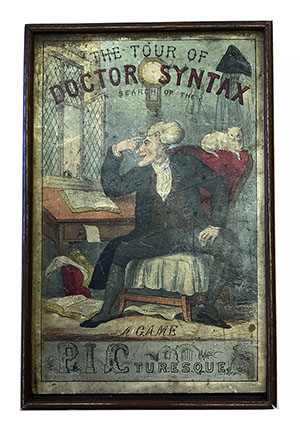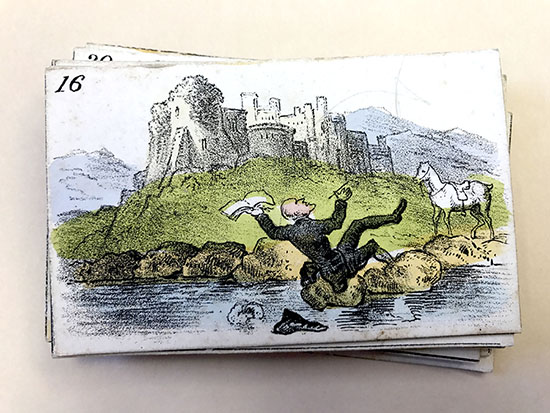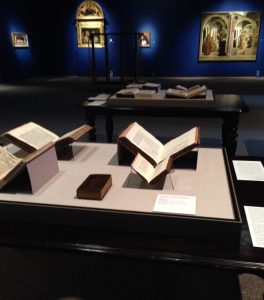 The North Carolina Museum of Art (NCMA) in Raleigh has borrowed six volumes from the Rare Book Collection for their current exhibition, Glory of Venice: Renaissance Paintings 1470-1520. Four of the books date from the Incunabula period, the first fifty years of printing with moveable type, 1450-1501. This group of volumes included a copy of Summa theologicae pars quarta by Antoninus (1480), La Commedia by Dante (1491), Aristophanis Comoediae novem by Aristophanes (1498), and Francesco Colonna’s Hypnerotomachia Poliphili (1499). Two slightly later Renaissance volumes, also printed in Venice, include Pliny the Elder’s Historia naturale di Caio Plinio Secondo (1510) and Hamishah humshe Torah (1533), also known as The Five Books of Moses, with Prophets and Hagiography. These books, printed in Venice and illustrated with woodcuts or painted miniatures, reflect the publishing and printing innovations happening in the city during the period represented by the exhibition’s paintings.
The North Carolina Museum of Art (NCMA) in Raleigh has borrowed six volumes from the Rare Book Collection for their current exhibition, Glory of Venice: Renaissance Paintings 1470-1520. Four of the books date from the Incunabula period, the first fifty years of printing with moveable type, 1450-1501. This group of volumes included a copy of Summa theologicae pars quarta by Antoninus (1480), La Commedia by Dante (1491), Aristophanis Comoediae novem by Aristophanes (1498), and Francesco Colonna’s Hypnerotomachia Poliphili (1499). Two slightly later Renaissance volumes, also printed in Venice, include Pliny the Elder’s Historia naturale di Caio Plinio Secondo (1510) and Hamishah humshe Torah (1533), also known as The Five Books of Moses, with Prophets and Hagiography. These books, printed in Venice and illustrated with woodcuts or painted miniatures, reflect the publishing and printing innovations happening in the city during the period represented by the exhibition’s paintings.
Loaning materials from the Rare Book Collection (or any of the Library’s special collections) is part of our outreach and research mission, and this arrangement with the NCMA is a particularly good example of how this kind of collaboration is beneficial. The choice of these six books was made after extensive research in Wilson Library’s reading room by the exhibition’s co-curator, Lyle Humphrey, and the page openings to be shown in the exhibition were also selected. The next step in a loan of this type was for the Library’s conservators to evaluate the condition of the volumes, carry out any minor repairs that might be necessary for safe display on the bindings or leaves, and to construct custom-fit supports for each of the volumes to remain open to the selected pages for the duration of the exhibition.
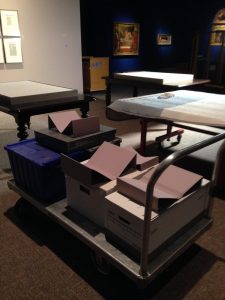
The books and the custom supports, referred to as cradles, were picked up by the NCMA art handlers and taken to the museum in advance of the day for installation of the books in the gallery. On Monday, February 27, 2017, the Library’s conservators and our colleague from Duke’s Rubenstein Rare Book and Manuscript Library, which was also lending books, went to the Museum to install the collection materials.
After associating each book with the specific cradle made for it, we stabilized the placement of the pages with narrow strips of polyethylene plastic to be certain that the pages remained open at the correct place.
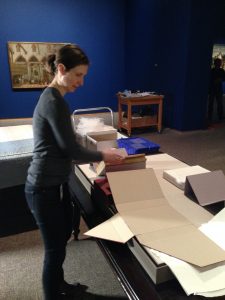
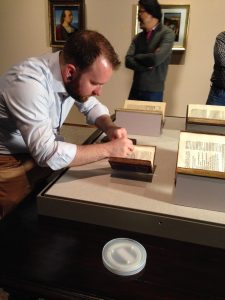

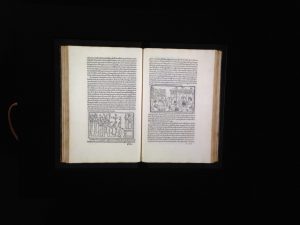
The Hypnerotomachia Poliphili, considered by many to be the most beautiful book of the Venetian Renaissance, was produced by the printer Aldus Manutius and includes 120 woodcuts. Because only two pages of a book can be seen in the static display of an exhibit case, the curator has included a digital surrogate of the entire volume on an iPad nearby, so visitors can see all of the visually arresting illustrations in this book.

Once all of the books were placed correctly and strapped for stability on their cradles, the vitrines that protect the volumes on display were installed. The books will return to the Rare Book Collection in a few months. Until then, Glory of Venice will be open at the North Carolina Museum of Art’s Meymandi Exhibition Gallery from March 4, 2017 – June 18, 2017.
This post was written by Jan Paris, Head of Conservation for Special Collections, Wilson Library

